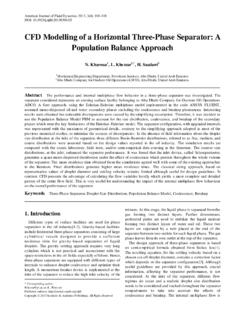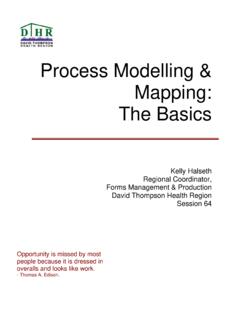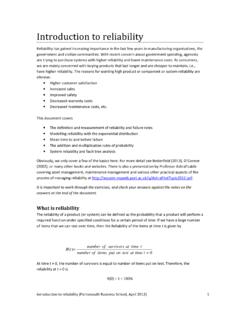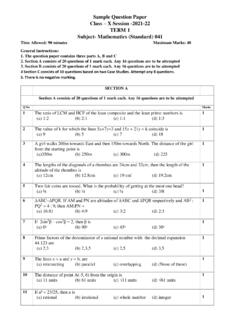Transcription of H4 Odour Management - GOV.UK
1 Additional guidance for H4 Odour Management How to comply with your environmental permit Published by: Environment Agency Horizon House, Deanery Road Bristol, BS1 5AH Tel: 0870 8506506 Email: Environment Agency All rights reserved. This document may be reproduced with prior permission of the Environment Agency. March 2011 GEHO0411 BTQM-E-E Contents 1. 2. Your permit 3 The Approval of Odour Management 3. Assessing the level of Odour pollution and appropriate measures .. 7 Step 1: Is there serious pollution?..7 Step 2: Is the operator taking appropriate measures?..9 4. Control 10 Receipt and Management of odorous materials ..10 Transfer of odorous chemicals to Containment of contaminated air ..11 End of pipe treatment ..12 Transport and Engaging your neighbours.
2 13 Responding to Ceasing or reducing Actions when problems arise your accident Management 5 16 Your monitoring plan ..16 Issues to take into account in any ambient air Complaints monitoring ..17 Sniff Odour diaries and community Grab samples and dilution Chemical monitoring Measuring Odour surrogates and process Fugitive Monitoring Appendices .. 23 Appendix 1 Appendix 2 Important Odour Appendix 3 Modelling Odour Appendix 4 What we are looking for in an Odour Management Environment Agency How to comply with your permit H4 Odour Management 1 Your permit conditions 1. Introduction This document is part of a suite of guidance notes issued by the Environment Agency1. These notes are designed to help both holders and potential holders of permits understand how to apply for, vary and comply with their permits.
3 This document supersedes the previous draft H4 guidance and the Environment Agency s internal guidance on the Management of Odour at waste facilities. The top level in this suite is How to Comply with your Permit which covers a large proportion of what an operator needs to know. There are then notes that cover issues specific to particular business sectors, and horizontal notes that go into more detail on particular topics such as risk assessment, noise or Odour . H4 is one of these horizontal topic notes. Click here2 to see a complete list of the sector and horizontal notes, which are all available from our website. The Environmental Permitting Regulations (the EP Regulations ) require the control of pollution including Odour . This guidance covers our regulatory requirements with regard to Odour , advice on the Management of Odour and the aspects that should be dealt with in an Odour Management plan (OMP).
4 This guidance does not apply to UWWTD3 facilities (unless they are subject to the IPPC Directive), standalone water discharges, groundwater authorisations, radioactive substance activities or any other activity which is not subject to an Odour condition in a permit. If you are making a new application you should first refer to the Environmental Permitting application form which will lead you through the necessary steps. Click here4 for the application form and 1 In consultation with NIEA. For the legislative framework in Northern Ireland contact NIEA at 2 Link to EPR guidance - 3 UWWTD Urban Waste Water Treatment Directive 4 Link to application form - 5 Contact NIEA for the equivalent in N. Ireland Environment Agency How to comply with your permit H4 Odour Management 2 Your permit conditions 2.
5 Your permit conditions For an explanation of how our approach to permitting delivers the requirements set out in legislation see RGN4 - Setting Standards in Environmental Permits. Depending on its age, your permit may express an Odour condition using different terms. For example, the permit may state that the operator must not cause nuisance, annoyance, offensive odours, offence to man s senses, interference with amenities, pollution etc. It may require the use of Best Available Techniques (BAT), appropriate measures, due diligence or all reasonable precautions to minimise Odour . The relevant legislation also uses a variety of terminology. For example, the Landfill Directive says Measures shall be taken to minimise nuisances and hazards arising from the landfill through emissions of odours , whereas the IPPC Directive includes Odour in the definition of pollution and says.
6 All the appropriate preventive measures are taken against pollution .. Whichever form of words is used in the permit we will treat it as having the same meaning as explained in Section 3. Accordingly, in this Guidance when we refer to the obligation not to cause pollution and the requirement to use appropriate measures we intend these expressions to encompass all the terms referred to above that may be found in the various Odour conditions. In other words, appropriate measures will be those that are required by the relevant legislation. For example, for IPPC installations, they will be BAT as defined in the IPPC/IED Directives or for waste sites they will be the relevant objectives as defined in the Waste Framework Directive. In most cases, however, the standard that is required for the control of Odour will be the same.
7 We would not require you to go beyond appropriate measures unless serious pollution was being caused. However, appropriate measures may require more measures to be taken where the risk of pollution is greater. Furthermore, there may be circumstances where you may choose to apply innovative methods which are not yet recognised as BAT, but which you consider to be necessary to solve a particular problem. The Conditions The current form of Odour condition used in our environmental permits is shown below and usually consists of two elements: the Odour boundary condition, which specifies the outcome which the operator must achieve ( no pollution beyond the site boundary); and a condition requiring compliance with an OMP (where activities are considered likely to give rise to Odour ) There may also be specific operational conditions relating to Odour control which require certain techniques or specify emission limits.
8 The Odour Boundary Condition Emissions from the activities shall be free from Odour at levels likely to cause pollution outside the site, as perceived by an authorised officer of the Agency, unless the operator has used appropriate measures, including, but not limited to, those Environment Agency How to comply with your permit H4 Odour Management 3 Your permit conditions specified in an approved Odour Management plan, to prevent or where that is not practicable to minimise the You must employ the appropriate measures necessary to prevent the Odour pollution or minimise it when prevention is not practicable. The measures that are appropriate will depend on your industry sector and your site-specific circumstances and will take costs and benefits into account. The underlined portion of the Odour boundary condition ensures that operators will not be in breach of that condition provided they are using appropriate measures.
9 However, even if the operator is using all appropriate measures, if we consider the residual Odour is at such a level that it is unreasonable it will be necessary for the operator to take further measures to reduce Odour pollution or risk having to reduce or cease operations. Where the residual Odour pollution is, or is likely to be, unacceptable we will work closely with operators to help them find solutions that will avoid this eventuality. The condition and the benchmarks given in this guidance are based on Odour levels at the boundary. If there are no receptors close to the boundary we will normally permit a facility that meets the criteria at the nearest receptor. However even where the facility has not caused Odour problems in the past the operator may have to take action to prevent or, where that is not practicable, minimise actual or potential Odour pollution if circumstances change a new residential development is built near to the site boundary.
10 You may decide to design to the tighter (boundary) standard to future-proof your investment. Figure 1 illustrates this approach. Unreasonable Odour amounting to serious pollution is being or is likely to be caused (regardless of whether appropriate measures are being used). You must take further action or you may have to reduce or cease operations. The Environment Agency would not issue a permit if it considered that you were likely to be operating at this level. Odour pollution is or is likely to be caused beyond boundary. Your duty is to use appropriate measures to minimise Odour . You are not in breach if you are using appropriate measures. If appropriate measures are being used, residual Odour will have to be tolerated by the community. For some activities appropriate measures will achieve no smell beyond the boundary.














